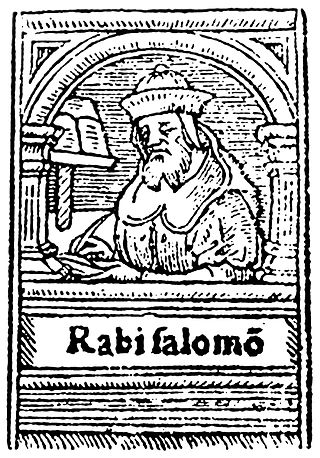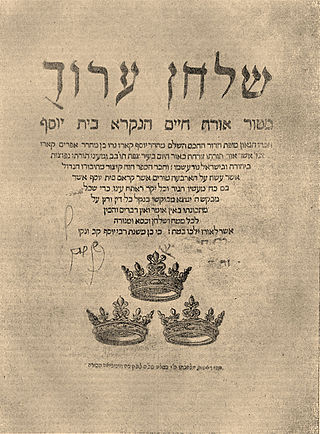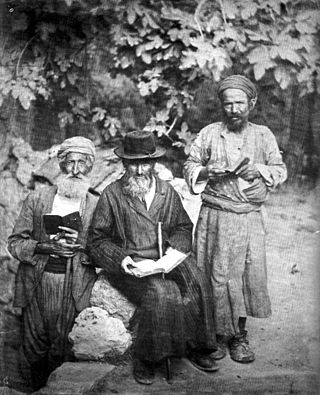
Shlomo Yitzchaki, generally known by the acronym Rashi, was a medieval French rabbi, the author of comprehensive commentaries on the Talmud and Hebrew Bible.
Gershom ben Judah, best known as Rabbeinu Gershom and also commonly known to scholars of Judaism by the title Rabbeinu Gershom Me'Or Hagolah, was a famous Talmudist and Halakhist.

The Shulchan Aruch, sometimes dubbed in English as the Code of Jewish Law, is the most widely consulted of the various legal codes in Judaism. It was authored in Safed by Joseph Karo in 1563 and published in Venice two years later. Together with its commentaries, it is the most widely accepted compilation of halakha or Jewish law ever written.
Responsa comprise a body of written decisions and rulings given by legal scholars in response to questions addressed to them. In the modern era, the term is used to describe decisions and rulings made by scholars in historic religious law.
Ovadia ben Jacob Sforno was an Italian rabbi, Biblical commentator, philosopher and physician. A member of the Sforno family, he was born in Cesena about 1475 and died in Bologna in 1549.
Nissim ben Reuven of Girona, Catalonia was an influential talmudist and authority on Jewish law. He was one of the last of the great Spanish medieval Talmudic scholars. He is also known by his Hebrew acronym, the RaN, or else with the definite article HaRaN, as well as by the name RaNbaR, the Hebrew acronym of his full name, including his father's name, Reuven, and also by Nissim Gerondi.
Geonim were the presidents of the two great Babylonian Talmudic Academies of Sura and Pumbedita, in the Abbasid Caliphate. They were generally accepted as the spiritual leaders of the Jewish community worldwide in the early medieval era, in contrast to the Resh Galuta (exilarch) who wielded secular authority over the Jews in Islamic lands.
Sherira bar Hanina more commonly known as Sherira Gaon was the gaon of the Academy of Pumbeditha. He was one of the most prominent Geonim of his period, and the father of Hai Gaon, who succeeded him as Gaon. He wrote the Iggeret Rav Sherira Gaon, a comprehensive history of the composition of the Talmud.
Israel Isserlin was a Talmudist, and Halakhist, best known for his Terumat HaDeshen, which served as one source for HaMapah, the component of the Shulkhan Arukh by Moses Isserles. He is also known as Israel of Neustadt, Israel of Marpurk, and Maharai.

Shlomo ben Avraham ibn Aderet was a medieval rabbi, halakhist, and Talmudist. He is widely known as the Rashba, the Hebrew acronym of his title and name: Rabbi Shlomo ben Avraham.
Mordechai ben Hillel HaKohen, also known as The Mordechai or, by some Sephardic scholars, as The Mordechie, was a 13th-century German rabbi and posek. His chief legal commentary on the Talmud, referred to as The Mordechai, is one of the sources of the Shulchan Aruch. He was killed in the Rintfleisch massacres in 1298.

Abraham Maimonides was the son of Maimonides and succeeded his father as nagid of the Egyptian Jewish community.
The history of responsa in Judaism, spans a period of 1,700 years. Rabbinic responsa constitute a special class of rabbinic literature, differing in form, but not necessarily in content, from Rabbinic commentaries devoted to the exegesis of the Bible, the Mishnah, the Talmud, and halakha. The codes themselves contain the rules for ordinary incidents of life. The responsa literature covers all these topics and more.
Isaac ben Abba Mari was a Provençal rabbi who hailed from Marseilles. He is often simply referred to as "Ba'al ha-Ittur," after his Magnum opus, Ittur Soferim.

David ben Solomon ibn (Abi) Zimra (1479–1573) also called Radbaz (רַדְבָּ"ז) after the initials of his name, Rabbi David iBn Zimra, was an early Acharon of the fifteenth and sixteenth centuries who was a leading posek, rosh yeshiva, chief rabbi, and author of more than 3,000 responsa as well as several scholarly works.
Joseph Colon ben Solomon Trabotto, also known as Maharik, was a 15th-century rabbi who is considered Italy's foremost Judaic scholar and Talmudist of his era.

Isaac ben Sheshet Perfet (or Barfat) (1326–1408) (Hebrew: יצחק בן ששת) was a Spanish Talmudic authority, also known by his acronym, Rivash (ריב"ש). He was born at Valencia and settled early in life at Barcelona, where he studied at the school of Nissim of Gerona.
Abraham ben Isaac of Narbonne (c. 1080-85 – 1158) was a Provençal rabbi, also known as Raavad II, and author of the halachic work Ha-Eshkol.

Judah ben Eliezer ha-Levi Minz, also known as Mahari Minz, was the most prominent Italian rabbi of his time. As his surname suggests, he immigrated around 1462 from Mainz to Italy. He officiated as rabbi of Padua for forty-seven years, during which time he had a great number of pupils, among whom were his son Abraham Minz, and the latter's son-in-law Meir Katzenellenbogen. In a dispute he had with Elia del Medigo, he was supported by Elijah Mizrachi.
Natronai Ben Hilai was Gaon of the Sura Academy early in the second half of the 9th century, and held this post for ten years. He is responsible for more written responsa to queries posed to him by world Jewry than any of his predecessors, and maintained close contact with the Spanish Jewish community.





